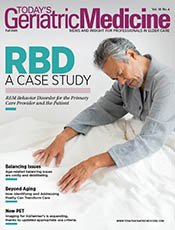
Fall 2025
Fall 2025 Issue The Last Word: The Hidden Danger How Untreated Sleep Apnea Puts Millions of Older Adults at Risk Untreated obstructive sleep apnea (OSA) severely affects overall health and quality of life in older adults, increasing the risk of cardiovascular disease, stroke, cognitive decline, and depression, while also exacerbating conditions like diabetes and hypertension, chronic fatigue, and poor sleep quality leading to depression. Fragmented sleep and intermittent hypoxia impair immune responses, increasing susceptibility to infections and slowing recovery from illnesses. Despite its prevalence, awareness and testing remain low due to a lack of routine screening, misinterpretation of symptoms as age-related changes, and limited knowledge among older adults and health care providers. Age-related muscle tone loss, obesity, and anatomical changes in the airway contribute to the high prevalence of OSA in older adults. Many cases can be traced back to underdeveloped upper and lower jaws, which lead to a restricted airway. Symptoms like fatigue, irritability, and memory difficulties are often attributed to natural aging rather than a treatable sleep disorder. Additionally, conditions like insomnia and fragmented sleep, common in older adults, can mask OSA symptoms. Many doctors overlook OSA in older adults, prioritizing other chronic conditions. Promoting early recognition and diagnosis is essential to mitigate these adverse health effects. Raising awareness and increasing screening for OSA in the aging population is critical to improving lifespan, cognitive function, and overall quality of life. Given the aging population, OSA is a public health crisis that needs greater awareness, better screening practices, and more accessible treatment options. Risks & Impact of Untreated OSA Cardiovascular Diseases Diabetes Cognitive Decline and Dementia These factors can impair memory, attention, and executive function. Early OSA diagnosis and treatment can protect cognitive function and support brain health in older adults. Challenges Understanding that the root cause of OSA often lies in anatomical factors, such as underdeveloped jaws, can also guide more accurate diagnosis and treatment using the latest technologies to remodel and restore proper airway form and function in adults of all ages. Collaborative care models involving primary care providers, sleep specialists, specially trained dentists, and other caregivers can facilitate timely diagnosis and intervention. Implementing routine sleep assessments using the latest home sleep testing equipment, especially for patients with chronic conditions, can improve diagnosis rates and lead to better management of OSA in older adults. Limitations of CPAP Therapy Benefits Final Thoughts To improve awareness and screening, health care providers should incorporate routine sleep assessments in annual wellness visits. Educational campaigns targeting older adults, caregivers, and providers can increase recognition of OSA symptoms. Caregivers play a crucial role in identifying changes in sleep patterns and behavior. Understanding the link between symptoms and jaw underdevelopment can also aid in a more accurate diagnosis. Multidisciplinary collaboration, including sleep specialists and geriatricians, ensures timely diagnosis and comprehensive management. Encouraging open discussions about sleep health can further reduce stigma and promote proactive care, empowering patients to be actively involved in their treatment decisions. Patients should actively participate in their treatment decisions, considering both options—CPAP and all forms of oral appliance therapy—to choose the solution best suited for their overall health and comfort. — Bahar Esmaili, DDS, is the vice president of clinical integration at Vivos Therapeutics (https://vivos.com). With over five years of experience transitioning from traditional dentistry to a focus on airway health, Esmaili brings a holistic approach to treating breathing disorders and their impact on overall health. Her expertise lies in addressing root causes of chronic health issues, emphasizing the connection between breathing, posture, and well-being. |
